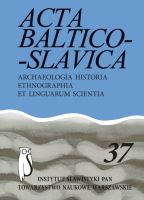Беларускія паўночна-заходнія занальныя моўныя адрозненні як вынік рэгіянальных этна-культу рных кантактаў і сувязяў
Features of north-west Belorussian dialects as a result of regional ethnocultural contacts and relations
Author(s): Vera AstrejkaSubject(s): Language and Literature Studies
Published by: Instytut Slawistyki Polskiej Akademii Nauk
Keywords: Belorussian language; northwest dialect zone; Slavic and Baltic interaction; Polish and Belorussian contacts; language support; language community; regiolect
Summary/Abstract: For a long time, north-west Belorussian dialects (and their predecessors) have been the area of different Slavic-Baltic contacts and relations. Interactions between Slavs and Balts took place here always on adstratum and substratum levels. These processes have led to the formation of the north-west dialect zone (= regiolect) of Belorussian. The corresponding linguistic phenomena form a basis of the north-west dialectal complex and can be discovered on every level of the language. As a rule, there are not many significant structural changes. However, some of them reflect certain tendencies and possibilities of the linguistic development in the region. These can achieve the status of structural innovations in the language. Belorussian-Polish language interaction is the second important moment in the formation of the north-west dialectal zone of Belorussian. The influence of Polish (both the dialectal and the standard varieties) on the Belorussian dialects can predominantly be discerned in the vocabulary and word-building mechanisms. The Baltic and especially Polish influences are also important for keeping some early linguistic phenomena alive and reinforcing their status as regional features of Belorussian dialects. Frequently, both factors have a joint effect. On the whole, the tendency to form a common repository of linguistic features is present in north-west Belorussian and neighbouring Baltic and Slavic dialects at any time. Therefore, we may say that the language is gradually forming a new independent variety with specific structure and a complex of distinctive features.
Journal: Acta Baltico Slavica
- Issue Year: 2013
- Issue No: 37
- Page Range: 311-322
- Page Count: 12
- Language: Belarusian

